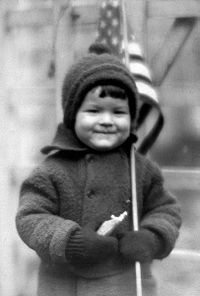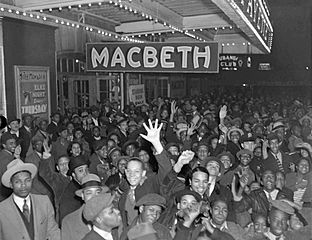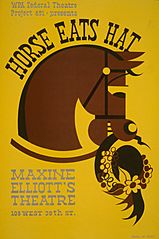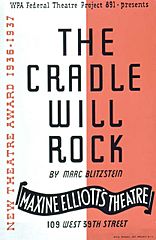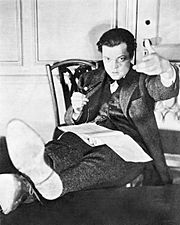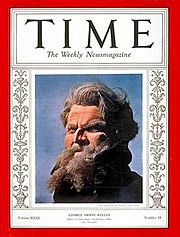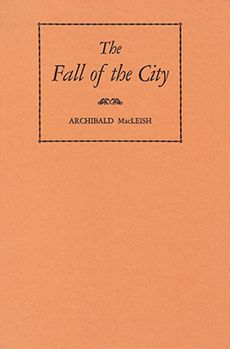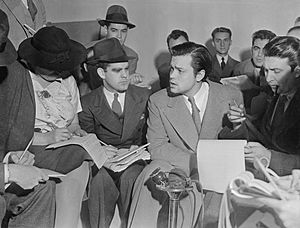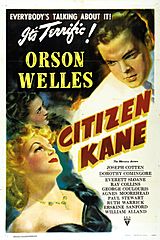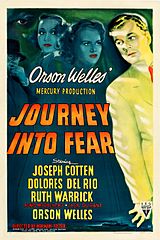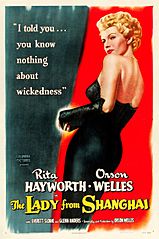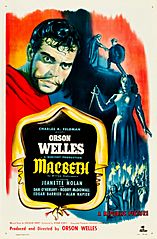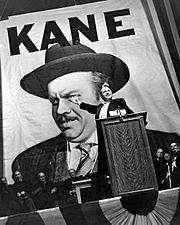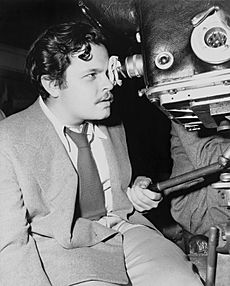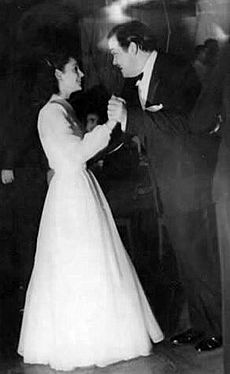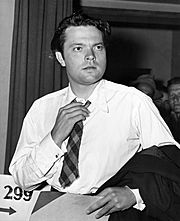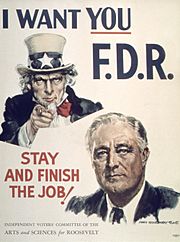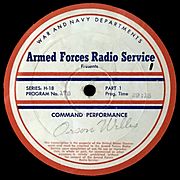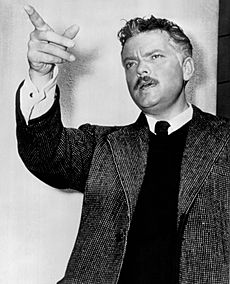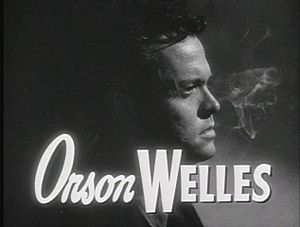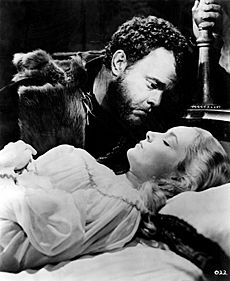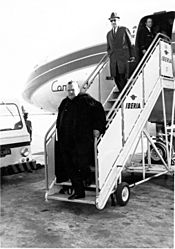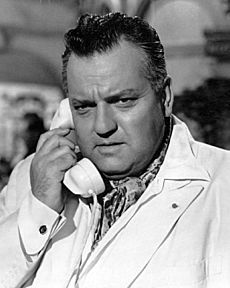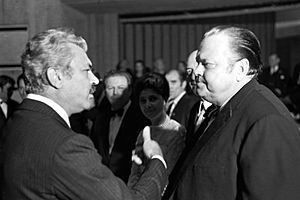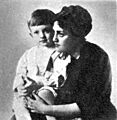Orson Welles facts for kids
Quick facts for kids
Orson Welles
|
|
|---|---|
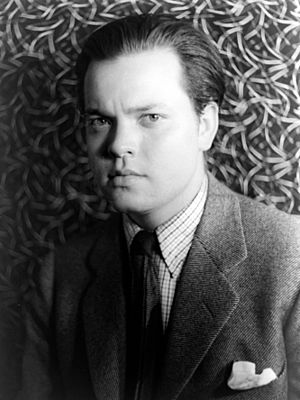
Welles in 1937, photographed by Carl Van Vechten
|
|
| Born |
George Orson Welles
May 6, 1915 Kenosha, Wisconsin, U.S.
|
| Died | October 10, 1985 (aged 70) Los Angeles, California, U.S.
|
| Resting place | Ronda, Andalusia, Spain |
| Occupation |
|
| Years active | 1931–1985 |
|
Notable work
|
Citizen Kane, The Magnificent Ambersons, The Lady From Shanghai, Touch of Evil, Chimes at Midnight, F For Fake |
| Political party | Democratic |
| Spouse(s) |
|
| Partner(s) |
|
| Children | 3, including Beatrice |
| Signature | |
George Orson Welles (May 6, 1915 – October 10, 1985) was an American actor, director, producer, and screenwriter. He is remembered for his amazing and new ideas in film, radio, and theatre. Many people think he was one of the greatest and most important filmmakers ever.
Contents
- Growing Up: Orson Welles's Early Life
- Starting Out: Orson Welles's Early Career (1931–1935)
- Theatre Adventures (1936–1938)
- Radio Stardom (1936–1940)
- Hollywood Years (1939–1948)
- European Years (1948–1956)
- Back to Hollywood (1956–1959)
- Back to Europe (1959–1970)
- Later Career (1970–1985)
- Personal Life
- Politics and Activism
- Death and Tributes
- Awards and Honors
- Images for kids
- See also
Growing Up: Orson Welles's Early Life
George Orson Welles was born on May 6, 1915, in Kenosha, Wisconsin. His parents were Richard Head Welles and Beatrice Ives Welles. He was named after his great-grandfathers.
Even though his family had money, Orson faced tough times as a child. His parents separated in 1919 and moved to Chicago. His father, who invented a popular bicycle lamp, stopped working. His mother, a talented pianist, played music to support them. Orson's older brother, Dickie, had learning difficulties and was sent to a special institution.
Beatrice, his mother, died in 1924 when Orson was just nine years old. After her death, Orson stopped playing music. He spent a summer with the Watson family in Wyoming, New York. There, he became friends with the children of the Aga Khan III. Later, he lived in Chicago with his father and Maurice Bernstein, a family friend and doctor.
Orson briefly went to public school. Then, his father stopped working completely and took Orson on trips to Jamaica and the Far East. When they returned, they lived in a hotel his father owned in Grand Detour, Illinois. After the hotel burned down, they traveled again.
Roger Hill, who became Orson's teacher and friend, once said, "In some ways, he was never really a young boy."
In 1926, Orson started at the Todd Seminary for Boys in Woodstock, Illinois. This was an expensive private school. At Todd School, he met Roger Hill, a teacher who later became the headmaster. Hill created a special learning environment for Orson, letting him focus on subjects he loved. Orson put on plays and tried out new theatre ideas there.
Critic Richard France wrote that Todd School gave Orson many valuable experiences. He could explore and experiment freely. The school even had its own radio station. Orson's first radio experience was on this station, where he performed his own version of Sherlock Holmes.
On December 28, 1930, when Orson was 15, his father died. Orson chose Maurice Bernstein to be his guardian. After graduating from Todd in 1931, Orson decided to travel instead of going to college. He studied painting for a few weeks in Chicago.
Orson often returned to Woodstock, Illinois. In a 1960 interview, when asked "Where is home?", he replied, "I suppose it's Woodstock, Illinois, if it's anywhere."
Starting Out: Orson Welles's Early Career (1931–1935)
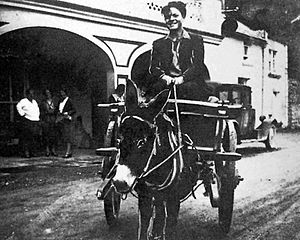
After his father passed away, Orson used some of his inheritance to travel to Europe. He said that while walking and painting in Ireland, he walked into the Gate Theatre in Dublin. He boldly claimed he was a Broadway star. The theatre manager, Hilton Edwards, was impressed by Orson's confidence and his audition.
Orson made his first stage appearance at the Gate Theatre on October 13, 1931. He played small roles in other plays and even produced his own shows in Dublin. In 1932, he performed in London but couldn't get a work permit, so he returned to the U.S.
Back in the U.S., Orson worked on a writing project at Todd School called Everybody's Shakespeare. This series of educational books was very successful and stayed in print for many years.
In 1933, Orson met famous writer Thornton Wilder in Chicago. Wilder helped Orson meet Katharine Cornell, a well-known actress who was forming a theatre group. Cornell's husband, director Guthrie McClintic, quickly hired Orson. Orson acted in three plays: Romeo and Juliet, The Barretts of Wimpole Street, and Candida. These plays toured for 36 weeks starting in November 1933.
In 1934, Orson got his first radio job with The American School of the Air. That summer, he put on a drama festival with the Todd School in Woodstock, Illinois. He also made his first short film, an eight-minute movie called The Hearts of Age.
On November 14, 1934, Orson married actress Virginia Nicolson in New York. A more formal ceremony took place later for her family.
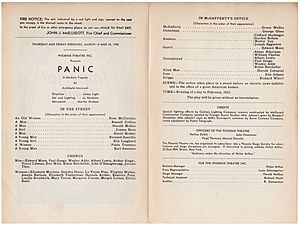
In December 1934, a new production of Romeo and Juliet opened on Broadway. Orson, then 19, played Tybalt. His performance caught the eye of John Houseman, a theatre producer. Houseman cast Orson in a new play called Panic. On March 22, 1935, Orson made his debut on the CBS Radio series The March of Time, performing a scene from Panic.
By 1935, Orson was also a busy radio actor in Manhattan. He worked with many actors who later joined his Mercury Theatre. He earned a lot of money from radio, almost as much as the highest-paid movie stars.
Theatre Adventures (1936–1938)
The Federal Theatre Project
The Federal Theatre Project was a government program during the Great Depression. It helped artists, writers, and theatre workers find jobs. It also made live theatre available to millions of Americans for the first time.
John Houseman invited Orson Welles to join the Federal Theatre Project in 1935. Orson was already very busy with radio work, earning a lot of money. He used his own radio earnings to fund his stage productions, which helped him create shows faster and better.
The Federal Theatre Project was perfect for Orson to develop his artistic skills. He could hire many artists and technicians. His first production was an adaptation of Shakespeare's Macbeth with an all African-American cast of 150 performers. This play became known as the Voodoo Macbeth. Orson changed the setting to a mythical island like Haiti, using Haitian vodou instead of Scottish witchcraft. The play opened on April 14, 1936, in Harlem and was a huge success. At 20, Orson was seen as a genius. The show then toured across the country.
Next, he directed the comedy Horse Eats Hat in 1936. This play featured Joseph Cotten in his first main role. After that came Dr. Faustus in 1937, which used lighting in new and interesting ways.
In 1937, Orson also worked on a political musical called The Cradle Will Rock. Its opening was canceled due to government budget cuts. The theatre was locked to prevent the use of government-bought materials. But Orson didn't give up! He told the audience to walk 20 blocks to another theatre. The musicians' union wouldn't let them play for lower wages, so the composer, Marc Blitzstein, played the piano on stage, and the actors sang from the audience. This unplanned performance was a big hit.
The Mercury Theatre
In 1937, Orson Welles and John Houseman left the Federal Theatre Project and started their own company, the Mercury Theatre. The name came from a magazine called The American Mercury. Orson was the main producer, and the group included actors like Joseph Cotten, George Coulouris, and Vincent Price.
Actor Norman Lloyd said Orson was the greatest director in American theatre. He explained that Orson's productions were complete works of art, with amazing staging, sets, music, sound, and lighting.
The Mercury Theatre opened on November 11, 1937, with Caesar. This was Orson's modern version of Shakespeare's Julius Caesar. It was an anti-fascist show that shocked Broadway. The stage was open with no curtain, and lighting created scene changes. It was staged like a political drama that happened the night before.
The success of the Mercury Theatre was so great that Orson appeared on the cover of Time magazine on May 9, 1938, just after his 23rd birthday.
Radio Stardom (1936–1940)
While working in theatre, Orson also worked a lot in radio as an actor, writer, director, and producer. Between 1935 and 1937, he earned up to $2,000 a week. He was so busy that he would often arrive at the studio just in time to quickly read his lines before going on air.
In 1937, Orson's performance as the announcer in The Fall of the City made him an overnight star at 21 years old.
In July 1937, the Mutual Network gave Orson a seven-week series to adapt Les Misérables. This was his first time directing and writing for radio, and it was a big success. He was the first to use narration in radio storytelling.
Later, Mutual chose Orson to play Lamont Cranston, also known as The Shadow. He played this role without being credited until 1938.
The Mercury Theatre on the Air
After his theatre successes, CBS Radio asked Orson Welles to create a summer radio show. It started on July 11, 1938, and was called The Mercury Theatre on the Air. Each week, the hour-long show presented radio plays based on classic books, with original music.
Orson Welles became instantly famous because of the Mercury Theatre's radio version of The War of the Worlds by H. G. Wells on October 30, 1938. The show was presented like news bulletins. Some listeners who tuned in late and missed the introduction thought the fictional reports of a Martian invasion were real. This caused a lot of confusion and even panic among some people. The story of this panic spread worldwide.
Orson's growing fame led to offers from Hollywood. He resisted at first. The Mercury Theatre on the Air soon got a sponsor, Campbell Soup, and was renamed The Campbell Playhouse.
In August 1939, Orson signed a film contract with RKO Pictures. He started traveling between California and New York for his Sunday radio shows. In November 1939, the show moved to Los Angeles. After 20 shows, Campbell Soup wanted more control over the stories. Orson decided not to renew his contract, and his time with Campbell ended in March 1940.
Hollywood Years (1939–1948)
-
Citizen Kane (1941)
RKO Radio Pictures offered Orson Welles an amazing contract. He was hired to write, produce, direct, and act in two movies. This contract gave him a lot of creative control, which was very unusual for a new filmmaker. He signed the full contract on August 21, 1939. Other Hollywood studios were not happy about this special deal.
Citizen Kane: A Masterpiece
RKO rejected Orson's first two movie ideas, but they agreed to his third: Citizen Kane. Orson co-wrote, produced, directed, and starred in the film. He developed the idea with screenwriter Herman J. Mankiewicz. The story was loosely based on the life of newspaper owner William Randolph Hearst.
Orson worked with some of Hollywood's best technical people, including cinematographer Gregg Toland. For the actors, Orson mostly used people from his Mercury Theatre group. Filming Citizen Kane took ten weeks. Orson called Toland "the greatest gift any director could ever have."
The film's music was created by Bernard Herrmann, who had worked with Orson in radio.
Hearst's newspapers tried to stop Citizen Kane from being released and pressured Hollywood to shelve the film. The head of RKO, George Schaefer, was even offered money to destroy the film.
While waiting for Citizen Kane to be released, Orson also directed a Broadway play called Native Son. This was the last time Orson and John Houseman worked together.
Citizen Kane was released in a limited way and received huge praise from critics. It was named the best picture of 1941 by several groups. It was nominated for nine Academy Awards but only won for Best Original Screenplay, which Orson shared with Mankiewicz. Some believed that unfair voting prevented it from winning more awards.
The film's delayed release and limited distribution meant it didn't make much money at first. It was stored away in 1942. However, after World War II, the film's reputation grew in France. In the U.S., it was re-evaluated after appearing on television in 1956. Today, Citizen Kane is widely considered one of the greatest films ever made.
The Magnificent Ambersons
Orson's second film for RKO was The Magnificent Ambersons, based on a famous novel. The cinematographer, Stanley Cortez, worked slowly, and the film went over budget and behind schedule. Before production, Orson's contract was changed, taking away his right to control the final version of the film.
Many actors from Citizen Kane returned for The Magnificent Ambersons, including Joseph Cotten and Agnes Moorehead. RKO cut more than forty minutes of the film and added a happy ending, which Orson did not want. The composer, Bernard Herrmann, even had his name removed from the credits because of the changes. Even with the studio's cuts, the film is still considered a classic.
While making the film, Orson also produced a weekly radio series, The Orson Welles Show. Many of the Ambersons cast members were on this show.
Film director Peter Bogdanovich once watched the film with Orson, who had tears in his eyes. Orson said it wasn't because the film was cut, but because "it's the past—it's over..."
Journey into Fear
Orson also worked on the spy thriller Journey into Fear, co-written with Joseph Cotten. Orson acted in and produced the film. He later said they were in such a hurry that whoever was closest to the camera directed each scene.
War Work and Goodwill
Goodwill Ambassador
In late 1941, Orson was asked to be a goodwill ambassador to Latin America by Nelson Rockefeller. The goal was to promote friendship between the U.S. and Latin American countries during World War II. Orson's mission was considered a success. He gave radio programs, lectures, and interviews. He worked for over six months without pay.
Orson's own hopes for the film were simple. He said It's All True was meant to be a good way to show people in the Northern Hemisphere something about the Southern one.
It's All True
In 1941, Orson planned It's All True as a film that would mix documentary and fiction. It was meant to be his third film for RKO. One part was to be about the history of jazz.
In December 1941, Orson was asked to make a film in Brazil about the Carnaval in Rio de Janeiro. He quickly edited The Magnificent Ambersons and finished his acting scenes in Journey into Fear. He flew to Brazil and started filming in February 1942.
However, RKO Pictures changed management in 1942. Orson's main supporter at RKO resigned. RKO took control of Ambersons and edited it. Orson's attempts to protect his version failed. In South America, Orson asked for more resources to finish It's All True, but RKO refused.
Orson later said, "So I was fired from RKO." He felt he never recovered from the false idea that he had wasted money.
Radio During Wartime (1942–1943)
Orson returned to the U.S. in August 1942. A week later, he hosted a seven-hour radio broadcast to raise money for War Bonds. The program raised over $10 million for the war effort.
In October 1942, Orson's radio play, Admiral of the Ocean Sea, about Christopher Columbus, was broadcast. It was part of an effort to promote unity between North and South America during the war.
Orson also produced and hosted two CBS Radio series: Hello Americans (1942–1943), which promoted understanding between American countries, and Ceiling Unlimited (1942–1943), which celebrated the aviation industry's role in the war. His shows were seen as important contributions to the war effort.
Throughout the war, Orson worked on many patriotic radio programs.
The Mercury Wonder Show
In early 1943, Orson's two radio series ended. He also finished filming the movie Jane Eyre. With this income, Orson decided to create a big show. He proposed a show that became a large circus and magic show. He offered to be the magician and director and invested about $40,000 of his own money. The show was called The Mercury Wonder Show for Service Men. Members of the U.S. armed forces could watch for free, and the public paid. The show entertained over 1,000 service members each night, and the money went to a charity for military personnel.
This show happened around the time Orson was declared unfit for military service due to health reasons. He felt bad about not being in the war.
The Mercury Wonder Show ran from August 3 to September 9, 1943, in a large tent in Hollywood. During a break on September 7, 1943, Orson and Rita Hayworth, who had just gotten married that day, were interviewed on the radio. Orson said the show had been performed for about 48,000 service members.
Radio Work Continues (1944–1945)
Orson's success as a guest host on The Jack Benny Program gave him the idea for his own radio variety show. The Orson Welles Almanac was a half-hour show that included comedy, magic, music, and readings. Many shows were performed at U.S. military camps to entertain the troops. The jazz band Orson put together for the show became very popular and helped bring back interest in traditional New Orleans jazz.
In May 1944, Orson was hired by the U.S. Treasury to help with the war effort. He led the Fifth War Loan Drive, which encouraged Americans to buy $16 billion in War Bonds to help pay for the D-Day landings. Americans bought over $20 billion in bonds during this drive.
Orson strongly supported President Franklin D. Roosevelt in 1944. He campaigned for Roosevelt almost full-time, traveling to many states. He also wrote a political column for The New York Post, supporting Roosevelt's New Deal policies and the idea of the United Nations.
When President Roosevelt died on April 12, 1945, Orson gave a special radio tribute. He emphasized the importance of continuing Roosevelt's work for a free world. He also advised and reported for the radio network covering the conference that formed the United Nations.
The Stranger
In late 1945, Orson began working on The Stranger (1946). This was a crime drama about a war crimes investigator tracking a Nazi fugitive. Edward G. Robinson, Loretta Young, and Orson starred in the film.
Orson was eager to direct this film on time and within budget. This was his first film directing job in four years. He was given some creative control and tried to make the film his own. He also wrote new scenes, though some were later cut by the producers.
The Stranger was the first commercial film to use real footage from Nazi concentration camps. Orson had seen this footage in May 1945.
The film was finished ahead of schedule and under budget. It was the only film Orson directed that was a big box office success when it was first released. However, despite its success, the studio did not give him the promised four-picture deal.
Around the World and Radio (1946)
In 1946, Orson moved to New York to direct a Broadway musical called Around the World, based on Jules Verne's novel. The producer left the show, and Orson had to fund it himself. When he ran out of money, he convinced Columbia Pictures president Harry Cohn to help. In return, Orson promised to make a film for Cohn for no extra fee. The stage show eventually failed.
Inspired by early filmmaker Georges Méliès, the show used films to connect scenes. Orson said it was his favorite stage production.
In 1946, Orson also started two new radio series: The Mercury Summer Theatre of the Air and Orson Welles Commentaries. The first show featured shorter versions of his classic radio plays. The second was a political show where he talked about current events. He brought a lot of attention to the case of Isaac Woodard, a Black veteran who was beaten and blinded by police officers.
The last broadcast of Orson Welles Commentaries in October 1946 marked the end of Orson's own radio shows.
The Lady from Shanghai
The film Orson had to make for Harry Cohn was The Lady from Shanghai, filmed in 1947 for Columbia Pictures. It was meant to be a small thriller, but the budget grew when Cohn suggested Orson's wife at the time, Rita Hayworth, co-star.
Cohn didn't like Orson's first cut of the film, especially the confusing plot. He ordered many changes and re-shoots. About an hour of Orson's original film was cut. Orson was especially upset about the music. The film was considered a failure in America when it came out. However, the final shootout scene in a hall of mirrors has become a famous part of film noir. Soon after the film's release, Orson and Rita Hayworth finalized their divorce.
While The Lady from Shanghai was praised in Europe, it wasn't popular in the U.S. until many years later. Now, it's often seen as a classic film noir.
Macbeth
Before 1948, Orson convinced Republic Pictures to let him direct a low-budget version of Macbeth. He used very stylish sets and costumes. The actors lip-synced to pre-recorded sound, which was one of many clever ways Orson saved money. The script, adapted by Orson, was a strong and violent version of Shakespeare's play.
Republic Pictures initially promoted the film but then decided they didn't like the Scottish accents. They delayed its release for almost a year. Orson went to Europe, and his co-producer, Richard Wilson, worked on the sound. Orson later returned and cut 20 minutes from the film. Macbeth was criticized as a disaster in America. However, it had fans in Europe, like the French filmmaker Jean Cocteau, who praised its "crude, irreverent power."
European Years (1948–1956)
In Italy, Orson starred in the 1948 film Black Magic. His co-star, Akim Tamiroff, impressed him so much that Tamiroff appeared in four more of Orson's films.
The next year, Orson played Harry Lime in Carol Reed's The Third Man, alongside his friend Joseph Cotten. Orson's character makes a very famous entrance and gives one of the most famous speeches in movies.
Orson also appeared in other films, like Prince of Foxes (1949) and The Black Rose (1950).
Othello
During this time, Orson used money from his acting jobs to fund his own film version of Shakespeare's play Othello. From 1949 to 1951, he filmed Othello in Italy and Morocco. The film featured his friends Micheál Mac Liammóir and Hilton Edwards.
Filming stopped several times because Orson ran out of money and had to take acting jobs. The American release of the film had sound problems. Orson's daughter, Beatrice Welles-Smith, later restored Othello in 1992, fixing the sound and adding effects. The restored film was very successful. Othello won the top prize at the Cannes Film Festival.
In 1952, Orson continued working in England. He hosted another radio series, The Black Museum, and acted in films like Trent's Last Case. In 1953, the BBC hired him to read from Walt Whitman's poem Song of Myself. He also played Professor Moriarty in a Sherlock Holmes radio series.
Orson briefly returned to America to appear on television for the first time. He starred in a live broadcast of King Lear on CBS in 1953.
In 1954, Orson acted in Three Cases of Murder and Trouble in the Glen. His old friend John Huston cast him as Father Mapple in the 1956 film Moby Dick.
Mr. Arkadin
Orson's next film as director was Mr. Arkadin (1955). It was filmed in Europe on a very small budget. Orson starred as a billionaire who hires a man to find out about his past. The film featured actors from his Harry Lime radio series and his third wife, Paola Mori. The producer, Louis Dolivet, took over the film's editing because Orson was working slowly. Five different versions of the film were released.
Television Projects
In 1955, Orson also directed two TV series for the BBC. Orson Welles' Sketch Book had him drawing and sharing memories. Around the World with Orson Welles was a series of travel shows about different places in Europe. Orson hosted and interviewed people, sharing facts and his own thoughts.
In 1956, Orson finished a film called Portrait of Gina. He left the only copy in his hotel room in Paris, where it was found decades later after his death.
Back to Hollywood (1956–1959)
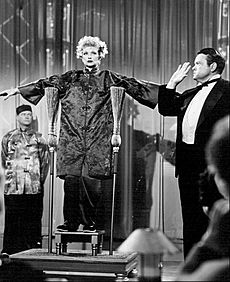
In 1956, Orson Welles returned to Hollywood. He began filming a TV pilot called The Fountain of Youth. This film was not aired until 1958, but it won an award for excellence.
Orson also made guest appearances on TV shows like I Love Lucy. On radio, he narrated Tomorrow (1956), a drama about a nuclear disaster. His next major film role was in Man in the Shadow (1957).
Touch of Evil
Orson stayed at Universal Studios to direct and co-star with Charlton Heston in the 1958 film Touch of Evil. Orson was only hired as an actor at first, but Heston insisted he direct. The film brought together many actors and crew members Orson had worked with before. Filming went smoothly, and the studio liked what they saw.
However, after filming, the studio re-edited the movie, re-shot scenes, and added new parts to make the plot clearer. Orson wrote a long memo with his suggestions and objections, saying the film was no longer his version. The movie won a grand prize at the 1958 Brussels World's Fair.
In 1998, the film was re-edited according to Orson's notes, and this version was praised. The film was important for its use of a handheld camera, especially in an elevator scene.
While Universal was re-editing Touch of Evil, Orson began filming his version of Don Quixote in Mexico.
Back to Europe (1959–1970)
Orson continued shooting Don Quixote in Spain and Italy, but he also took on acting jobs. In 1959, he directed his own scenes as King Saul in David and Goliath. He co-starred in Ferry to Hong Kong (1959) and Crack in the Mirror (1960). He also acted in Yugoslavian films like The Tartars and Battle of Neretva.
Throughout the 1960s, filming for Don Quixote continued on and off. Orson changed the story and ending many times. Even though he had a complete version at one point, he kept changing it. He even burned 10 reels of a version where Quixote and Sancho Panza went to the moon because the 1969 moon landing made that ending seem old. Orson ended up voicing all the characters himself. In 1992, another director tried to put together a film from Orson's leftover footage.
In 1961, Orson directed In the Land of Don Quixote, a TV series for Italian television. It was like his earlier travel shows and featured his wife, Paola, and daughter, Beatrice.
The Trial
In 1962, Orson directed his film The Trial, based on the novel by Franz Kafka. The cast included Anthony Perkins. While filming outside in Zagreb, Orson learned that the producers had run out of money for sets. So, he filmed the indoor scenes in an abandoned railway station in Paris, which he felt was perfect for Kafka's story. The film did not do well at the box office. Orson later said it was his best film. While making The Trial, Orson met Oja Kodar, who became his partner and worked with him for the rest of his life.
Orson continued to act, narrate, or host other people's projects. He also began filming Chimes at Midnight, which he finished in 1965.
Chimes at Midnight
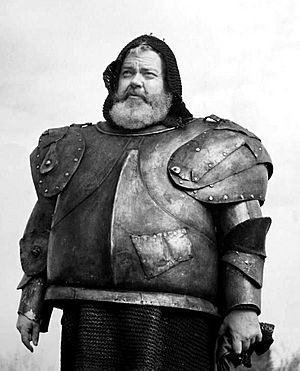
Filmed in Spain, Chimes at Midnight was based on Orson's play, Five Kings. In this film, he used parts from six Shakespeare plays to tell the story of Sir John Falstaff (played by Orson) and his friendship with Prince Hal. The film's narration was taken from a historical writer. Orson thought very highly of this film, saying, "It's my favorite picture, yes. If I wanted to get into heaven on the basis of one movie, that's the one I would offer up."
In 1966, Orson directed a film for French television, The Immortal Story. It was successful in French theaters. Around this time, Orson and Oja Kodar began working together. He also appeared briefly as Cardinal Wolsey in A Man for All Seasons, a role for which he received much praise.
In 1967, Orson started directing The Deep, filmed off the coast of Yugoslavia. He and Oja Kodar personally financed it, but they couldn't get enough money to finish it, and it was abandoned. In 1968, Orson began filming a TV special called Orson's Bag, which combined travel, comedy, and a short version of Shakespeare's The Merchant of Venice. However, funding problems stopped the show from being completed.
In 1969, Orson played a supporting role in The Kremlin Letter. He moved back to America in 1970, drawn by many offers to work in TV and films.
Later Career (1970–1985)
Orson Welles returned to Hollywood and continued to pay for his own film and TV projects. He still received many offers to act, narrate, and host. He also appeared frequently on TV talk shows like Dick Cavett and Johnny Carson.
His main project in his final years was The Other Side of the Wind, filmed off and on between 1970 and 1976. This film, co-written with Oja Kodar, is about an aging film director looking for money to finish his last movie. The film ran into legal problems after the Shah of Iran was removed from power. These legal issues kept the film unfinished until 2017, and it was finally released in November 2018.
Orson played Louis XVIII of France in the 1970 film Waterloo.
In 1971, Orson directed a short film version of Moby-Dick, a one-man show on a bare stage. He also appeared in Ten Days' Wonder. That same year, the Academy of Motion Picture Arts and Sciences gave him an Academy Honorary Award for his amazing work in movies. Orson pretended to be out of town and sent John Huston to accept the award for him.
In 1972, Orson narrated the documentary Future Shock. He also played Long John Silver in the film Treasure Island. This was the last time he played the main role in a major film.
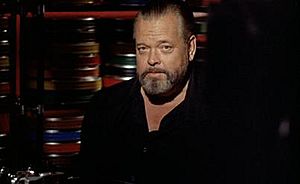
In 1973, Orson completed F for Fake, a film about art forger Elmyr de Hory. It included new material with Oja Kodar and other actors. Orson also hosted a British TV series called Orson Welles's Great Mysteries (1973–74). In 1974, he lent his voice to the film Ten Little Indians.
In 1975, Orson narrated the documentary Bugs Bunny: Superstar. The American Film Institute also gave him a Lifetime Achievement Award.
In the late 1970s, Orson appeared in many famous TV commercials. For two years, he was the spokesman for Paul Masson Vineyards, and sales increased. He also did voiceovers for Carlsberg beer and Findus frozen foods. When he needed more money, he started directing commercials himself.
In 1981, Orson hosted the documentary The Man Who Saw Tomorrow, about the prophet Nostradamus. In 1982, the BBC broadcast The Orson Welles Story, an interview where Orson talked about his past. He also provided narration for the heavy metal band Manowar's albums.
In the 1980s, Orson worked on other film projects like The Dreamers and Orson Welles' Magic Show, but none were completed.
In 1984, Orson narrated the TV series Scene of the Crime. He was also the voice of the unseen character Robin Masters in the TV show Magnum, P.I.. His death meant this character was mostly written out of the series. He also released a music single called "I Know What It Is to Be Young (But You Don't Know What It Is to Be Old)".
His last film roles included voice work in the animated films Enchanted Journey (1984) and The Transformers: The Movie (1986), where he voiced the villain Unicron. His last on-screen film appearance was in Someone to Love, released after his death. His last TV appearance was an introduction to an episode of Moonlighting, which aired five days after he died and was dedicated to his memory.
Personal Life
Relationships and Family
Orson Welles married actress Virginia Nicolson on November 14, 1934. They separated in 1939 and divorced in 1940.
Orson met Mexican actress Dolores del Río in 1939. Their relationship was kept secret at first. They acted together in the movie Journey into Fear (1943). Their relationship ended in 1943.
Orson married famous actress Rita Hayworth on September 7, 1943. They divorced on November 10, 1947.
In 1955, Orson married Italian actress Paola Mori. They were married in London on May 8, 1955, and remained married until his death.
Croatian artist and actress Oja Kodar became Orson's long-time partner and collaborator from 1966 onwards. They lived together for much of the last twenty years of his life.
Orson Welles had three daughters: Christopher Welles Feder (born 1938, with Virginia Nicolson), Rebecca Welles Manning (1944–2004, with Rita Hayworth), and Beatrice Welles (born 1955, with Paola Mori).
Politics and Activism
Orson Welles was involved in politics from the start of his career. He always supported left-wing and progressive ideas. As a Democrat, he spoke out against racism in the United States and segregation. He strongly supported President Franklin D. Roosevelt and his New Deal policies. He campaigned a lot for Roosevelt in the 1944 election.
Orson once recalled that President Roosevelt joked with him, saying, "Orson, you and I are the two greatest actors alive today." Roosevelt also encouraged him to run for a Senate seat.
In a 1970 TV interview, Orson claimed to have met Adolf Hitler while hiking in Austria. He said Hitler made no impression on him at all and seemed to have no personality until he was in front of a large crowd.
In 1946, Orson used his radio show to demand justice for Isaac Woodard, a Black veteran who was beaten and blinded by white police officers. Orson dedicated several broadcasts to Woodard's case. The NAACP felt these broadcasts greatly helped the Justice Department take action.
For several years, Orson wrote a newspaper column about political issues. He thought about running for the U.S. Senate in 1946.
Orson's political activities were noted in Red Channels, an anti-Communist publication that contributed to the Hollywood blacklist. He was in Europe during the time of the Red Scare, which further isolated him from Hollywood.
In 1982, Orson spoke at a large nuclear disarmament rally in Central Park, criticizing the policies of President Ronald Reagan.
Death and Tributes
On the evening of October 9, 1985, Orson Welles recorded his last interview on The Merv Griffin Show. He returned home and worked late into the night on a new project. Orson died on the morning of October 10, 1985, from a heart attack. He was 70 years old.
Orson was cremated. A small private funeral was held for his family and a few close friends.
A public memorial tribute took place on November 2, 1985, in Los Angeles. Many friends and colleagues spoke about his life and work.
Joseph Cotten said Orson did not want a funeral but wished to be buried quietly in Spain. Cotten sent a message to the memorial, ending with lines from a Shakespeare sonnet Orson had sent him.
Peter Bogdanovich, who was directed by Orson, said that working with him was like "breathing pure oxygen all day long." He described Orson as always in control, never angry or impatient, and always hilarious.
In 1987, Orson Welles's ashes were taken to Ronda, Spain. They were buried in an old well covered by flowers on the estate of his friend, bullfighter Antonio Ordóñez.
Awards and Honors
- 1933: Orson's play Twelfth Night for the Todd School won first prize at the Chicago World's Fair.
- 1938: As director of the Mercury Theatre, Orson received an award for his great contribution to theatre.
- 1941: Citizen Kane won the New York Film Critics Circle Award for Best Picture.
- 1942: Citizen Kane was voted Best Film of 1941 by the National Board of Review. Orson was also recognized for his acting.
- 1942: Citizen Kane was nominated for nine Academy Awards, including Best Picture, Best Director, and Best Actor for Orson. It won the Academy Award for Best Original Screenplay, which Orson shared.
- 1952: Othello won the top prize at the 1952 Cannes Film Festival.
- 1958: Touch of Evil won the International Critics Prize at the Brussels World Film Festival. Orson was also honored for all his work.
- 1959: Orson received a special Peabody Award for The Fountain of Youth, a TV pilot.
- 1966: Chimes at Midnight won the 20th Anniversary Prize and the Technical Grand Prize at the Cannes Film Festival.
- 1970: The Venice Film Festival gave Orson the Golden Lion for his Career Achievement.
- 1970: Orson received an Academy Honorary Award for his outstanding work in movies.
- 1975: Orson received the American Film Institute Lifetime Achievement Award.
- 1979: Orson was inducted into the National Association of Broadcasters Broadcasting Hall of Fame.
- 1982: In Paris, French President François Mitterrand gave Orson the Order of Commander of the Légion d'honneur, France's highest civilian award.
- 1984: The Directors Guild of America gave Orson its highest honor, the D. W. Griffith Award.
- 1988: Orson was inducted into the National Radio Hall of Fame.
- 1998: The American Film Institute ranked Citizen Kane as the greatest American movie.
- 1999: The American Film Institute named Orson Welles one of the top 25 male movie stars of Classic Hollywood cinema.
- 2002: Orson was voted the greatest film director of all time in two British Film Institute polls.
- 2003: A crater on Mars was named in his honor.
- 2007: A statue of Orson Welles was placed in Split, Croatia.
- 2013: The Woodstock Opera House in Woodstock, Illinois, dedicated its stage to Orson Welles, where he made his American debut as a theatre director.
Images for kids
-
Welles's birthplace in Kenosha, Wisconsin (2013)
See also
 In Spanish: Orson Welles para niños
In Spanish: Orson Welles para niños


